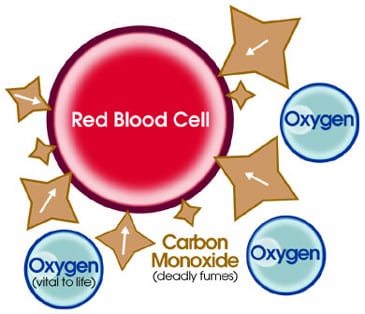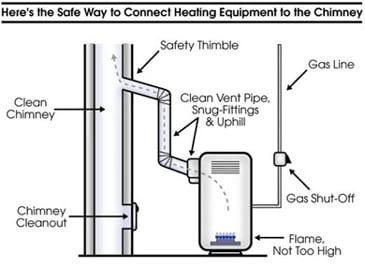Exactly what I was trying to say but they listen to you.:)…at least you got a ditto. lol
I agree with Bob and David.
While the fan may contribute to a condition, it is likely not the root-cause.
Case is point is where a commercial-style range is installed in the kitchen, requiring a higher CFM fan/hood. If this were the case, then why would one ever recommend a smaller CFM fan?
No. Our job is NOT to recommend a repair or pretend that we know why the condition exists. Our position in this particular case would be to identify a CO condition which occurrs. We can say we observed it when we did something, but caution that there can be multiple contributing factors.
Report and referr to a professional.
As Linas has stated, this is a Life Safery issue. We have detected a condition and report on it accordingly.
R2000 homes are pretty tight 1/2 an air change/hr. Many of them are so tight they cause health issues even after applying a HRV and interlock with Exhaust fans. I don’t think you would need your houses constructed like our area David.
I see everyone’s point on this issue. I should have said in the report that the furnace backdrafted and need to be furhter evaluated and repaired by a licensed HVAC technician. The kitchen fan should not have been noted. I guess it’s the Newbie thing biting me in the a s s again.
No Greg you are right to mention it.
Fact I observed backdrafting on using the kitchen hood.
Opinion is hood is creating a negative air pressure situation meaning home may be sealed to tightly not allowing makeup air to enter and create updraft.
Guidance is to have a HVAC Tech examine the flue system.
I did not explain what FOG means earlier as I am often busy on a report or in the field when I come in here.
Imagine never doing a narrative report style and only clicking canned comments in the field generated report .
Do not see how guys do it.
Bob is correct. I also stated that you could report that the condition occurred when you energized the fan.
You are unsure of the root cause. Observe and report.
Exactly.
This applies to any and all situations.
Just 2 hours ago.
I had a crawlspace crack near a support beam and the veneer (exterior opposite) was cracked with sealed weeps,open ledge,trim on mid ledge towards home plus slab crack in crawl spreading from the beam/foundation crack.
Confusing so rather than pick an opinion I decided to explain the situation and recommend a Structural engineer plus a tuckpointer.
When in doubt describe the best you can and pick a specialist.
Not a cop out and better than guessing.
Better than many Newbies since many of them don’t care to even test for back drafting.
I don’t know how you could have turned on the dryer and not have a back draft as we are required to test them at 160 cfm and this is less than 90 cfm.
CSA-F326 http://www.homeenergy.org/show/article/nav/singlefamily/page/20/id/1241
You need to get out of the books and courses to experience the real world!
The vast majority of new construction homes in this area have the furnace and water heater in the garage. I turn all bath fans, kitchen fans and a dryer if available at the same time I turn on the furnace and water heater. I find that about 60%-70% of new homes have backdrafting if the door from the home to the garage is open.
Think it is a far fetched scenario? How about Thanksgiving with the family visiting. Snow outside so all the windows are closed, Grandma is cold so the heat is on, people using all the bathrooms requesting hot water, someone cooking in the kitchen, the laundry is going for fresh sheets, and dad is showing off the motorcycle in the garage but keeps the door open/ajar to hear when the game starts. 10 minutes? 20 minutes? How long to affect the home and inhabitants if all these items continue for hours?
A prime reason why a single CO detector is not enough. You would be surprised at the number of homes this affects.
First signs is a headache and dizziness and since the family may be drinking the next is death!
http://www.cdc.gov/co/faqs.htm
Frequently Asked Questions
**What is carbon monoxide?**
Carbon monoxide, or CO, is an odorless, colorless gas that can cause sudden illness and death.
Where is CO found?
CO is found in combustion fumes, such as those produced by cars and trucks, small gasoline engines, stoves, lanterns, burning charcoal and wood, and gas ranges and heating systems. CO from these sources can build up in enclosed or semi-enclosed spaces. People and animals in these spaces can be poisoned by breathing it.
What are the symptoms of CO poisoning?
The most common symptoms of CO poisoning are headache, dizziness, weakness, nausea, vomiting, chest pain, and confusion. High levels of CO inhalation can cause loss of consciousness and death. Unless suspected, CO poisoning can be difficult to diagnose because the symptoms mimic other illnesses. People who are sleeping or **intoxicated **can die from CO poisoning before ever experiencing symptoms.
How does CO poisoning work?
Red blood cells pick up CO quicker than they pick up oxygen. If there is a lot of CO in the air, the body may replace oxygen in blood with CO. This blocks oxygen from getting into the body, which can damage tissues and result in death.
Who is at risk from CO poisoning?
All people and animals are at risk for CO poisoning. Certain groups — unborn babies, infants, and people with chronic heart disease, anemia, or respiratory problems — are more susceptible to its effects. Each year, more than 400 Americans die from unintentional CO poisoning, more than 20,000 visit the emergency room and more than 4,000 are hospitalized due to CO poisoning. Fatality is highest among Americans 65 and older.
How can I prevent CO poisoning from my home appliances?
- Have your heating system, water heater and any other gas, oil, or coal burning appliances serviced by a qualified technician every year.
- Do not use portable flameless chemical heaters (catalytic) indoors. Although these heaters don’t have a flame, they burn gas and can cause CO to build up inside your home, cabin, or camper.
- If you smell an odor from your gas refrigerator’s cooling unit have an expert service it. An odor from the cooling unit of your gas refrigerator can mean you have a defect in the cooling unit. It could also be giving off CO.
- When purchasing gas equipment, buy only equipment carrying the seal of a national testing agency, such as the CSA Grouphttp://www.cdc.gov/TemplatePackage/images/icon_out.png.
- Install a battery-operated or battery back-up CO detector in your home and check or replace the battery when you change the time on your clocks each spring and fall.
How do I vent my gas appliances properly?
- All gas appliances must be vented so that CO will not build up in your home, cabin, or camper.
- Never burn anything in a stove or fireplace that isn’t vented.
- Have your chimney checked or cleaned every year. Chimneys can be blocked by debris. This can cause CO to build up inside your home or cabin.
- Never patch a vent pipe with tape, gum, or something else. This kind of patch can make CO build up in your home, cabin, or camper.
- Horizontal vent pipes to fuel appliances should not be perfectly level. Indoor vent pipes should go up slightly as they go toward outdoors. This helps prevent CO or other gases from leaking if the joints or pipes aren’t fitted tightly.
How can I heat my house safely or cook when the power is out?
- Never use a gas range or oven for heating. Using a gas range or oven for heating can cause a build up of CO inside your home, cabin, or camper.
- Never use a charcoal grill or a barbecue grill indoors. Using a grill indoors will cause a build up of CO inside your home, cabin, or camper unless you use it inside a vented fireplace.
- Never burn charcoal indoors. Burning charcoal — red, gray, black, or white — gives off CO.
- Never use a portable gas camp stove indoors. Using a gas camp stove indoors can cause CO to build up inside your home, cabin, or camper.
- Never use a generator inside your home, basement, or garage or near a window, door, or vent.
How can I avoid CO poisoning from my vehicle?
- Have a mechanic check the exhaust system of my car every year. A small leak in your car’s exhaust system can lead to a build up of CO inside the car.
- Never run a car or truck in the garage with the garage door shut. CO can build up quickly while your car or truck is running in a closed garage. Never run your car or truck inside a garage that is attached to a house and always open the door to any garage to let in fresh air when running a car or truck inside the garage.
- If you drive a vehicle with a tailgate, when you open the tailgate, you also need to open vents or windows to make sure air is moving through your car. If only the tailgate is open CO from the exhaust will be pulled into the car.
90 cfm is not that much and not the source of the problem. You want a kitchen fan to produce at least 100 cfm. Even the newest house will have plenty of make up air for 90 cfm. The issue is either with the appliances venting or its make up air. A qualified BPI certified rater should be able to test further and make a good recommendation.

